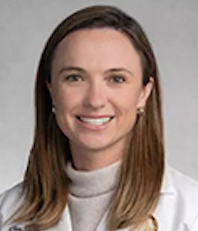Q & A with Dr. Ann Gaffey
 Ann Gaffey, MD, is a board-certified vascular surgeon who specializes in a wide spectrum of vascular diseases including complex treatment of thoracic and abdominal aortic aneurysms, peripheral arterial disease, carotid disease, thoracic outlet syndrome and hemodialysis access. Dr. Gaffey completed fellowship training in vascular surgery and endovascular therapy, residency training in general surgery and a master's degree in translational research at the University of Pennsylvania Perelman School of Medicine in Philadelphia. She earned her medical degree from Georgetown University School of Medicine in Washington, District of Columbia.
Ann Gaffey, MD, is a board-certified vascular surgeon who specializes in a wide spectrum of vascular diseases including complex treatment of thoracic and abdominal aortic aneurysms, peripheral arterial disease, carotid disease, thoracic outlet syndrome and hemodialysis access. Dr. Gaffey completed fellowship training in vascular surgery and endovascular therapy, residency training in general surgery and a master's degree in translational research at the University of Pennsylvania Perelman School of Medicine in Philadelphia. She earned her medical degree from Georgetown University School of Medicine in Washington, District of Columbia.
Dr. Gaffey's clinical interests include examining new approaches to peripheral arterial disease and improving the patency of current bypass options. As an assistant professor of surgery at UC San Diego School of Medicine, she trains medical students, residents and fellows in the Division of Vascular and Endovascular Surgery. Dr. Gaffey was drawn to vascular surgery primarily for the opportunity to develop lifelong relationships with her patients while working together to manage all aspects of their vascular health. She is able to offer a myriad of treatments from medical management, structured exercise, endovascular interventions and open surgery tailored to each patient. Dr. Gaffey finds nothing more rewarding than earning her patient's trust and becoming part of their healthcare team.
For this month's Q&A, we discuss the key challenges she faces treating peripheral arterial disease, what sets her apart from other physicians and why she has made research a key focus of her career.
Q: Your clinical interests include examining new approaches to Peripheral arterial disease and improving the patency of current bypass options. What drives your interest in this area and what, from your perspective, are the key challenges?
AG: Peripheral artery disease (PAD) is a serious global health burden that most people do not initially know they have. PAD eventually leads to amputation, loss of independence, reduced quality of life, and ultimately death. When we see generations after generations coming in with amputations, we must acknowledge our current failures and need to change our approaches. In my opinion, the two biggest challenges to improve are outcomes in PAD are overcoming the sequelae of diabetes and end-stage renal disease.
Q: What would you say sets you apart from other physicians in terms of interacting with patients?
AG: It may should cliché but every day that I interact with patients it is a true joy. As Shirley Chisholm notes: “Service is the rent we pay for the privilege of living on this earth.” I take this statement to heart when I operate on a patient who has entrusted me with their life or see a patient in clinic. I view my relationships with patients has lifelong friendships and such continuity of care is truly one of the gifts of vascular surgery.
Q: You recently received a Surgery Engineering Pilot Award for designing and evaluating a steerable acoustically active sheath for aneurysm repair. What is unique about this project and how do you anticipate it will improve the field?
AG: As we continue to forge ahead with endovascular therapies, tackling more complex problems, radiation exposure to operators, surgical room staff, and the patient continues to rise as well as the burden on the operator’s technical skills. A steerable and acoustically augmented sheath will serve to provide auditory feedback to the operator through a change in flow dynamics near the orifice of the targeted artery. Overall, Dr. James Friend and I suspect that this added tool will help to reduce operative time and radiation dose to the staff.
Q: You are a true surgeon scientist with more than 87 peer-reviewed manuscripts, abstracts, and book chapters. Why have you made research a core focus of your career?
AG: As vascular surgeons who can see the long terms effects of atherosclerotic disease, aneurysmal disease, and physiology at the granular level, I believe we are uniquely positioned to morph the knowledge we obtain in the clinical atmospheres into research opportunities to help improve the care of our patients and communities. Furthermore, I enjoy working with undergrad, medical students, and research fellows who are always trying to push the field forward—it is truly a rewarding part of my career.
Q: You also train medical students, residents, and fellows in the Division of Vascular and Endovascular Surgery. How have things changed for trainees since you yourself were a resident/fellow?
AG: It is truly an honor to be engaged in all levels of medical training. I often joke with the trainees of how much has changed in a mere 18 months but after a near decade of training, I can say that we have improved the surgical training. More progress to shoring up the pipeline is necessary, and I can see that the Department of Surgery at UC San Diego is committed to this front.
Q: If you could put any message up on a gigantic billboard seen by the public at large, what would it say?
AG: Save a Limb and Save a Life! PAD Awareness
